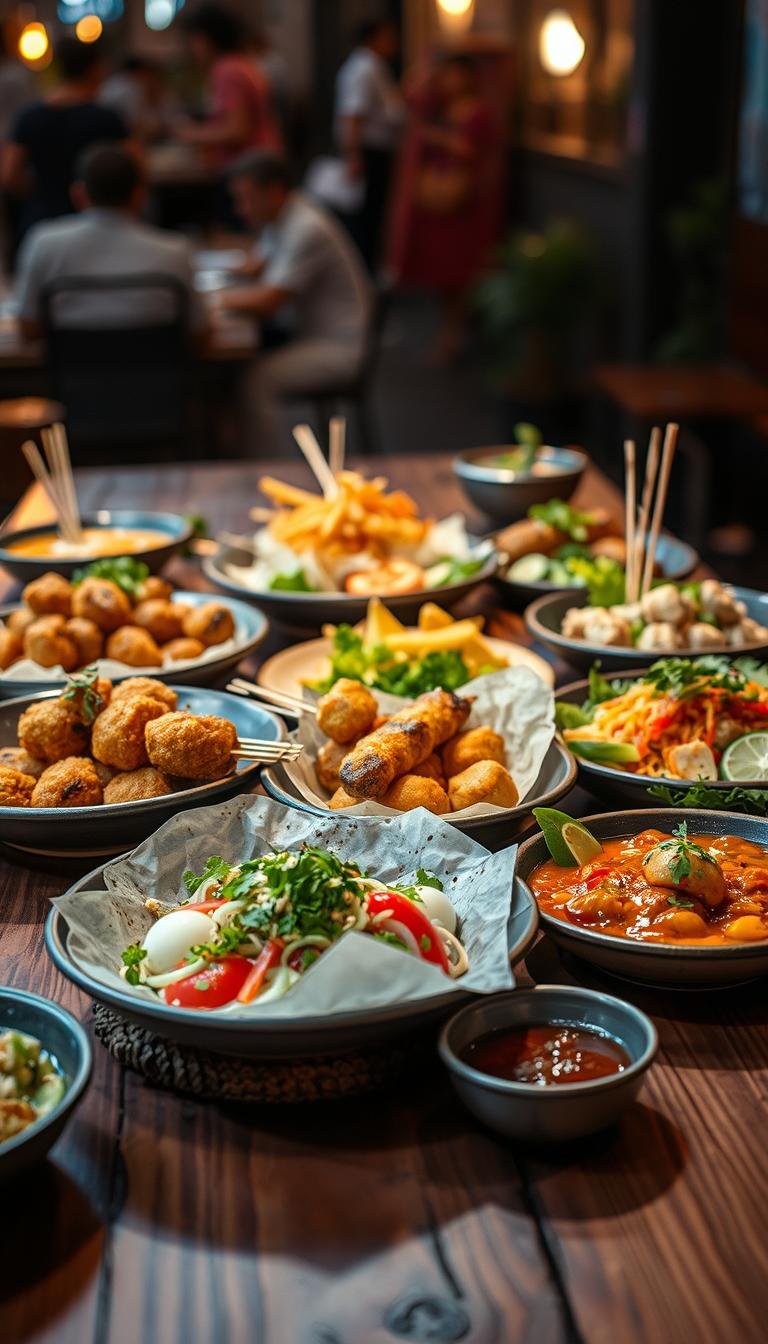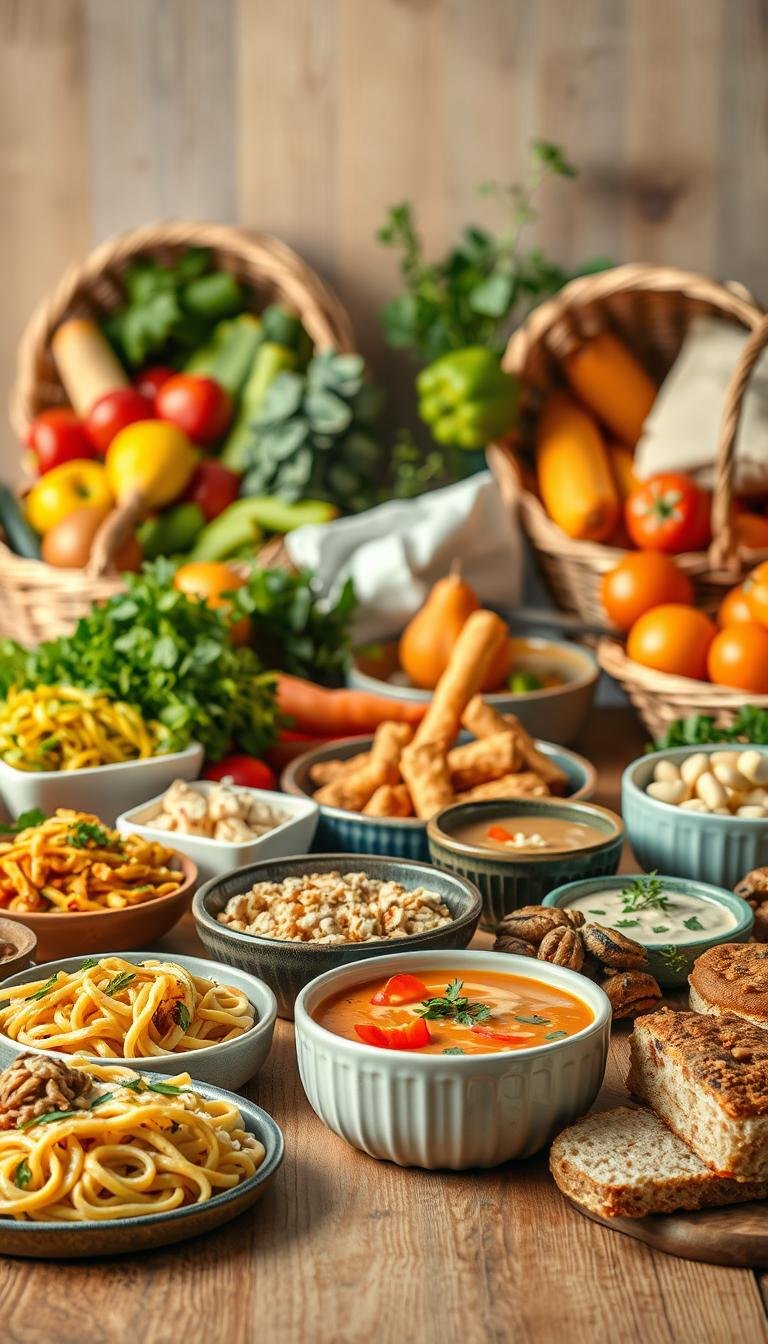Exploring the world through its culinary traditions is a journey like no other. Street food, in particular, offers a unique window into cultures, showcasing flavors and techniques passed down through generations. It’s more than just a meal—it’s a story on a plate.
According to TasteAtlas, a platform that uses 1,591 legitimate ratings from knowledgeable users, street food dishes are ranked based on authenticity and popularity. This crowd-sourced approach highlights the best of traditional cuisine, making it easier for food enthusiasts to discover hidden gems.
Small plates, inspired by street food, provide an accessible way to explore diverse flavors. They allow you to sample a variety of dishes without committing to a full meal. This approach not only supports local vendors but also promotes sustainability by reducing food waste.
Whether you’re recreating these dishes at home or enjoying them on the go, street food offers a democratized dining experience. It’s a celebration of the world’s culinary diversity, one bite at a time.
Key Takeaways
- Street food is a gateway to understanding cultural traditions.
- TasteAtlas ranks dishes using crowd-sourced ratings for authenticity.
- Small plates make culinary exploration accessible and fun.
- Supporting local vendors promotes sustainability.
- Street food dishes can be easily adapted for home cooking.
Why Street Food-Inspired Small Plates Are a Culinary Adventure
Every bite tells a story when it comes to authentic culinary experiences. Street vendors craft dishes using generations-old techniques, offering a direct connection to local traditions. These flavors, now adapted into small plates, let you explore cultures without leaving your table.

The Appeal of Global Street Food
Street food isn’t just about quick meals—it’s about discovery. Take Mustafa’s Döner Kebabs in Berlin. People cross the city just to taste their legendary recipe. This dish, like many others, carries history in every layer.
Historical records show street food dates back to ancient marketplaces. A 50-country guide reveals how these dishes evolved alongside cities. From Oshski samsa in Kyrgyzstan to Mexican elote, each has roots in local economies and daily life.
How Small Plates Bring Variety to Your Table
Small plates remove the fear of commitment. You can sample spicy shrimp tacos, veggie spring rolls, and stuffed mushrooms in one meal. This approach mirrors the excitement of wandering through a night market.
Vegetarian adaptations prove how flexible these dishes can be. Traditional meat-heavy recipes now feature plant-based twists, like mini veggie spring rolls. It’s all about creativity with ingredients.
| Dish | Origin | Key Ingredient |
|---|---|---|
| Döner Kebab | Germany/Turkey | Spiced meat, flatbread |
| Oshski Samsa | Kyrgyzstan | Lamb, flaky pastry |
| Mini Caprese Skewers | Italy | Mozzarella, cherry tomatoes |
Language barriers fade when sharing these plates. A smile and pointed finger often lead to the best discoveries. That’s the magic of food—it speaks when words fail.
Top Global Street Food Inspired Small Plates for Variety
Dive into a world of bold flavors with these culinary treasures. Each dish tells a story of tradition, innovation, and cultural heritage. Whether you’re a fan of savory bites or sweet treats, these creations are sure to delight your palate.

Asian-Inspired Bites: Dumplings and More
Asian cuisine offers a wide range of flavors, and dumplings are a standout. From Chinese jiaozi filled with pork or shrimp to Japanese takoyaki, these bites are both versatile and delicious. Each region adds its unique twist, making every bite a new experience.
For a gluten-free option, try rice-based dumplings. Pair them with sweet chili or soy sauce for an extra burst of flavor. These dishes are perfect for sharing or enjoying on your own.
Latin American Flavors: Empanadas and Arepas
Latin America brings hearty and flavorful dishes to the table. Colombian arepas de queso, made with cornmeal and cheese, are a must-try. They’re crispy on the outside and soft on the inside, offering a satisfying texture.
Empanadas, stuffed with chicken or beef, are another favorite. Their flaky crust and rich fillings make them a crowd-pleaser. Don’t forget to dip them in salsa verde for an added kick.
Middle Eastern Delights: Kebabs and Falafel
Middle Eastern cuisine is known for its bold spices and fresh ingredients. Armenian lavash-wrapped kebabs are a prime example. They combine tender meat with warm bread for a comforting meal.
Falafel, made from chickpeas, is a vegetarian-friendly option. Serve it with tahini sauce for a creamy, nutty flavor. These dishes are perfect for those looking to explore new tastes.
| Dish | Origin | Key Ingredient |
|---|---|---|
| Jiaozi | China | Pork, shrimp |
| Arepas de Queso | Colombia | Cornmeal, cheese |
| Lavash-Wrapped Kebabs | Armenia | Chicken, bread |
These dishes are more than just meals—they’re a celebration of culture. Whether you’re exploring new flavors or revisiting old favorites, there’s always something new to discover.
How to Incorporate Street Food Flavors at Home
Bringing the vibrant essence of cultural cuisines into your kitchen is easier than you think. With a few key ingredients and simple techniques, you can recreate the bold flavors of traditional dishes right at home. Whether you’re a seasoned cook or just starting, these tips will help you master the art of street food-inspired meals.

Essential Ingredients for Authentic Taste
To capture the true essence of street food, start with pantry staples like sumac, harissa, and dendê oil. These ingredients add depth and authenticity to your dishes. For example, sumac brings a tangy flavor to Middle Eastern recipes, while harissa adds a spicy kick to North African dishes.
Don’t forget basics like garlic, salt, and oil. These are the foundation of many recipes. Fresh vegetables and beans can also elevate your meals, providing texture and nutrition. With these ingredients on hand, you’re ready to explore a world of flavors.
Quick and Easy Recipes to Try
Start with a simple Egyptian koshari recipe. This dish combines lentils, rice, and pasta for a hearty meal. Top it with a spicy tomato sauce and crispy onions for extra flavor. It’s a crowd-pleaser that’s easy to prepare.
For a Sri Lankan twist, try kottu made with chopped paratha. This dish is quick to make and packed with flavor. Add your favorite vegetables and spices for a personalized touch.
If you’re short on time, use store-bought roti for Malaysian murtabak. This hack saves time without sacrificing taste. Vegetarian? Swap jackfruit for al pastor in your tacos for a plant-based alternative.
- Experiment with fava bean falafel for a protein-rich snack.
- Follow a step-by-step guide for Hungarian langos, a fried bread delight.
- Master takoyaki pan techniques for perfect Japanese street food.
- Plan meal prep strategies to enjoy a variety of small plates throughout the week.
With these tips and recipes, you can bring the excitement of street food into your home. It’s a delicious way to explore new cultures and flavors, one dish at a time.
Street Food Small Plates from Europe
Europe’s culinary heritage shines through its diverse street food offerings. From crispy fritto misto in Italy to hearty döner kebabs in Germany, these dishes are a testament to centuries of tradition. Each bite brings you closer to the culture and history of its origin.

Italian Fritto Misto and Beyond
Naples is famous for its fritto misto, a mix of fried seafood served in a paper cone. This dish is part of the Neapolitan cuoppo tradition, enjoyed by locals and visitors alike. The crispy texture and fresh flavors make it a must-try.
For a sweet treat, pair Spanish churros with hot chocolate. This combination is a favorite in cafes and street stalls across Spain. Tuscan crostini, topped with cheese and herbs, offer a savory alternative that’s perfect for sharing.
German Döner Kebabs and Hungarian Langos
Berlin’s döner kebabs are a modern classic, blending Turkish and German influences. Compare them to Bosnian ćevapi, which use similar spiced meat but are served in flatbread. Both dishes are hearty and satisfying.
Hungarian langos, a fried bread topped with garlic and cheese, is a comfort food staple. Crete’s bugatsa, a 100-year-old recipe, features flaky pastry filled with cheese or custard. These dishes highlight the versatility of bread in European cuisine.
| Dish | Origin | Key Ingredient |
|---|---|---|
| Fritto Misto | Italy | Seafood |
| Döner Kebab | Germany | Spiced meat |
| Langos | Hungary | Bread, garlic |
- Explore Crete’s bugatsa for a taste of history.
- Try British chip butty for a simple yet satisfying meal.
- Serve Alsatian flammkuchen as a unique dinner option.
African and Middle Eastern Street Food Gems
African and Middle Eastern cuisines offer a treasure trove of flavors waiting to be explored. From hearty stews to fresh salads, these regions bring unique tastes to the table. Each dish tells a story of tradition, innovation, and cultural heritage.

Egyptian Koshari and Moroccan Tagine
Egyptian koshari is a comforting dish that combines lentils, rice, and pasta. It’s topped with a spicy tomato sauce and crispy fried onions, creating layers of texture and flavor. This dish is a staple in Egyptian homes and street stalls alike.
Moroccan tagine, on the other hand, is a slow-cooked stew made with tender meat, vegetables, and aromatic spices. Adapting this dish for a slow cooker makes it an easy yet impressive meal. Both dishes showcase the rich culinary traditions of their regions.
Turkish Simit and Israeli Salad
Turkish simit is a sesame-coated bread ring that’s perfect for breakfast or a snack. Its crunchy exterior and soft interior make it a favorite across Turkey. Pair it with a cup of tea or coffee for a simple yet satisfying treat.
Israeli salad is a refreshing mix of diced tomatoes, cucumbers, and herbs, often dressed with tahini sauce. This dish highlights the freshness of vegetables and is a great accompaniment to any meal. It’s a testament to the simplicity and flavor of Middle Eastern cuisine.
- Break down koshari’s layered textures for a complete sensory experience.
- Master the sesame coating technique for perfect Turkish simit.
- Pair your meal with an Ethiopian coffee ceremony for an authentic touch.
- Try Jordanian knafeh, a sweet dessert made with cheese and syrup.
- Adapt Moroccan tagine for slow cookers to save time without losing flavor.
- Highlight shakshuka as a brunch crossover dish featuring eggs and tomato sauce.
- Include Sudanese ful medames, a hearty breakfast made with fava beans.
For more insights into African culinary traditions, explore this guide. These dishes are more than just meals—they’re a celebration of culture and history.
Vegetarian and Vegan Street Food Options
Discovering plant-based culinary traditions opens up a world of vibrant flavors. From hearty meals to light snacks, vegetarian and vegan dishes showcase creativity and cultural diversity. These options are not only delicious but also adaptable to various dietary preferences.

Plant-Based Small Plates from Around the World
Indian aloo tikki, made with spiced potatoes, is a popular snack that’s both crispy and satisfying. Guatemalan chuchito adaptations use corn dough filled with vegetables and cheese, offering a gluten-free alternative. These dishes highlight how simple ingredients can create bold flavors.
Bangladeshi singara pastry, a vegan version of samosas, is filled with spiced potatoes and peas. For a hearty meal, try Salvadoran pupusas stuffed with beans and plant-based cheese. These recipes prove that plant-based eating can be both flavorful and fulfilling.
How to Adapt Meat Dishes for Vegetarians
Indonesian nasi campur can be made vegetarian by substituting tempeh for meat. This dish combines rice, vegetables, and spices for a balanced meal. Jackfruit carnitas tacos are another great option, offering a meaty texture without the meat.
Ethiopian fasting dishes, like lentil stews, are naturally vegan and packed with flavor. Lebanese mujadara, made with lentils and caramelized onions, is a comforting dish that’s easy to prepare. Argentinian empanadas can be adapted with squash and polenta for a plant-based twist.
- Experiment with fava bean falafel for a protein-rich snack.
- Try vegan versions of traditional dishes for a creative twist.
- Explore vegan street food recipes for more inspiration.
These dishes show that vegetarian and vegan options can be just as exciting and flavorful as their meat-based counterparts. Whether you’re a seasoned plant-based eater or just starting, there’s always something new to discover.
Pairing Drinks with Street Food Small Plates
The right beverage can transform a meal into a memorable event. Whether you’re hosting a dinner or enjoying a casual meal, the perfect drink pairing enhances the flavors of your dish. From wines and beers to non-alcoholic options, there’s a way to complement every culinary creation.

Best Wines and Beers for Global Flavors
Pairing drinks with food is an art. For Thai satay, a crisp Riesling balances the spicy peanut sauce. Belgian fries come alive with lambic beers, offering a tangy contrast. Georgian khachapuri pairs beautifully with amber wines, while Argentinian empanadas shine alongside a bold Malbec.
For a refreshing side, try micheladas with Mexican elote. This beer-based drink complements the smoky, spicy flavors of the dish. Experimenting with these pairings can elevate your dining experience.
Non-Alcoholic Pairings for Every Dish
Non-alcoholic options are just as exciting. Hibiscus agua fresca adds a floral note to Latin American dishes. Turkish simit pairs perfectly with çay, a traditional tea that enhances the bread’s sesame flavor. Brew authentic Moroccan mint tea for a refreshing finish to any meal.
For a creative twist, design zero-proof cocktail flights. These can include fruity, herbal, and spicy options to match a variety of dishes. Non-alcoholic pairings ensure everyone can enjoy the flavors.
| Dish | Drink Pairing |
|---|---|
| Thai Satay | Riesling |
| Belgian Fries | Lambic Beer |
| Georgian Khachapuri | Amber Wine |
| Argentinian Empanadas | Malbec |
- Match Riesling with Thai satay for a balanced flavor.
- Suggest lambic beers for Belgian fries to add tanginess.
- Create hibiscus agua fresca for a refreshing non-alcoholic option.
- Pair Georgian khachapuri with amber wines for a rich experience.
- Contrast Argentinian empanadas with Malbec for bold flavors.
- Brew authentic Moroccan mint tea for a soothing finish.
- Design zero-proof cocktail flights for creative pairings.
Tips for Hosting a Street Food-Inspired Gathering
Hosting a gathering with diverse flavors can be both fun and memorable. Whether you’re planning a casual get-together or a themed party, these tips will help you create an unforgettable experience. Focus on a mix of flavors, textures, and presentation styles to keep your guests engaged.

Creating a Diverse Menu
Start by curating a menu that offers a variety of tastes. Include dishes from different regions to give your guests a culinary journey. For example, pair spicy tacos with refreshing spring rolls and savory kebabs. This approach ensures there’s something for everyone.
Use color-coded plates to cater to dietary needs. This simple trick helps guests easily identify options that suit their preferences. Balance spicy, sweet, and savory elements to create a well-rounded meal.
Presentation Ideas for Small Plates
Presentation plays a big part in making your gathering special. Use street vendor-style paper cones for fries or snacks. Incorporate edible leaves as plates for a unique touch. These small details can elevate the overall experience.
Set up DIY stations for tacos or banh mi. This interactive element allows guests to customize their meals. It’s a great way to keep people engaged and entertained throughout the day.
| Dish | Presentation Idea |
|---|---|
| Tacos | DIY station with toppings |
| Spring Rolls | Edible leaves as plates |
| Kebabs | Street-style paper cones |
- Curate a 5-continent tasting journey for variety.
- Suggest portion sizes per guest to avoid waste.
- Include interactive elements like DIY simit.
- For more ideas, explore finger foods for inspiration.
Conclusion
Culinary traditions offer a unique lens into the heart of cultures. By exploring street food, we preserve heritage while embracing innovation. Each dish tells a story, connecting us to the world in a meaningful way.
Small plates not only provide variety but also promote sustainability. They encourage us to experiment in our kitchens, bringing global flavors to our tables. Platforms like TasteAtlas continue to rank authentic meals, guiding us to the best restaurants and recipes.
Consider rotating seasonal menus to keep your culinary journey fresh. Share your creations and inspire others to explore new tastes. Together, we can celebrate the rich tapestry of global cuisine, one bite at a time.



